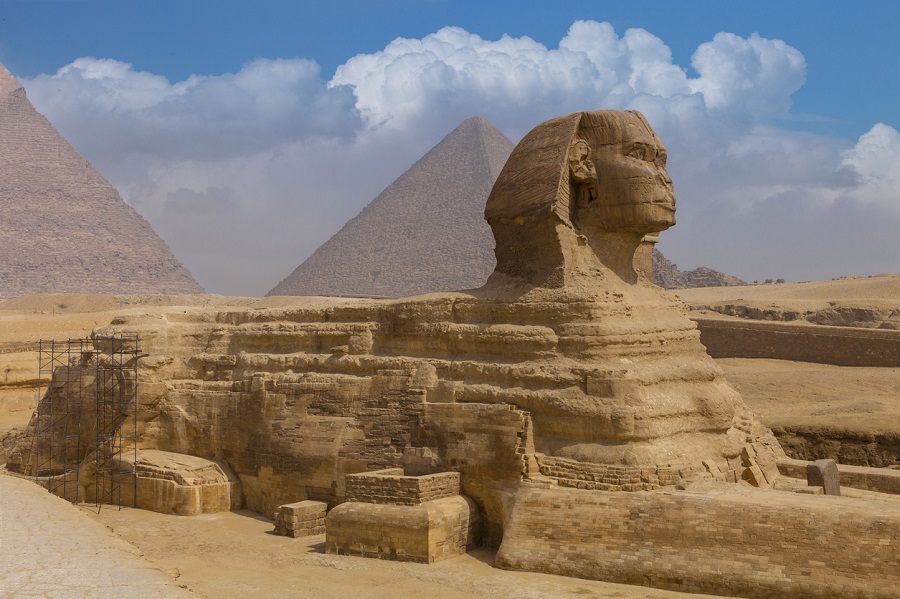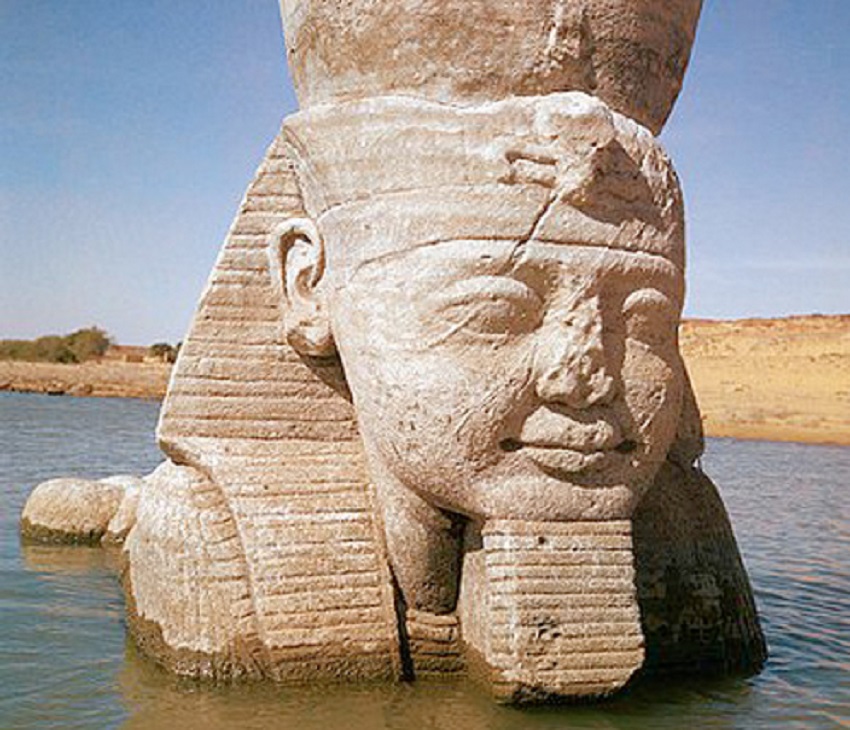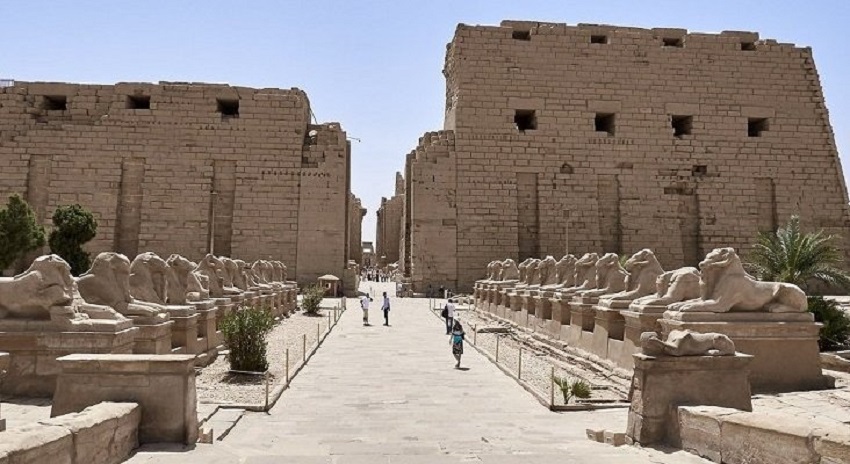Ancient Egypt is marked with various symbols that can have a connotation related to life, death or simply worship. These have been reflected in their constructions as well as in numerous objects, one of the most outstanding being the egyptian sphinx and it is through this article that we will know everything about it.

The Egyptian Sphinx
The sphinx is an ancient symbol associated with the sun in the civilizations of the East of the world, especially the Egyptians. For dynastic pharaohs, this symbol, which was itself a spiritual guardian, became a tradition to replicate their king's face and head carved as the upper body of a lion in his tomb complex or in some temple.
This affinity of the pharaoh and the lion itself manifested the king's link with the powerful solar deity Sekhmet, who was the daughter of the sun god "Ra", who reflects herself with the head of a lioness. Similarly as a symbol of the sun, the Egyptian Sphinx has also been associated with Harmakhis the "Lord of the Two Horizons", who represents the rising and setting sun, which is identified with rebirth and resurrection.
The sphinx obtained great value in terms of its meaning that was later imported from Egypt, both to Asia and Greece around the fifteenth to sixteenth century BC. Compared to the Egyptian model, the Asian sphinx had eagle wings, was feminine, and crouched with one leg raised in her representation. While in Greek traditions, the sphinx also had wings as well as a serpent's tail; in the legends it devours all the travelers who cannot answer its enigma.
Etymology
The word sphinx obtained a denomination by the ancient Egyptians as (Sheps-anj), whose connotation refers to "living figure" or "living statue", from this word came sefanjes and then sphinx. Likewise, the Greek historian Herodotus gave the name of the Egyptian Sphinx "Androsphinx", which, in contrast to the Greek that had a feminine face and wings, had a face with masculine features.
Other forms with which the sphinx is usually figured is with animal features, so it could be obtained with the upper part of a ram (cryosphinxes) or a falcon (hieracosphinxes).
History
The Egyptian Sphinx, in addition to being a symbol of the pharaoh whose personification was that of a super being that contained omnipotent power and wisdom with which he governed and protected his people, was also attributed the allegory of the mysteries, the truth, unity and life after death.
In addition, the sphinxes were represented in various ways as mentioned above, but according to the place or time this differs, such as that of the human face with lion's mane, especially in Nubia, and that of the New Kingdom of Egypt attributed to various gods such as Amun with the face of a ram.
What is notorious is that the exact date on which the first sphinx appeared is unknown, and that the most famous Egyptian Sphinx of all is the Great Sphinx of Giza, although it has not yet been dated exactly; however, some scholars associate it with the reign of Cheops, around 2500 BC. C. And in relation to her, there is a story where it is related that Tutmosis IV during the XVIII dynasty when he was a simple prince, went on a hunting expedition and fell asleep in the shadow of the sphinx.
When the prince slept, he dreamed that the sphinx communicated with him where he promised that he would be king if he removed the sand that had accumulated around the base of the statue. So during the reign of Khafre, sphinxes became widespread, so they were all used as guards outside temples, tombs, and funerary monuments.
An example of how the Egyptians used this symbology can be seen in the temples of Amun in Karnak and Luxor where a hundred of these Egyptian Sphinxes with human or ram features are placed in an avenue one side and one side before the entrance. From the temple.
https://www.youtube.com/watch?v=ytSM9FYdAtc&t=9s
It is clear that the image of the Egyptian Sphinx has evolved in a certain way over time and according to the cultural environment, however, in this area of the East of the world some representations with feminine features are well known, such as:
- The sphinx that personifies the queen of the ancient Egyptian Empire Hetepheres II, spouse of Pharaoh Dyedefra of the IV dynasty. This is one of the oldest found of this civilization.
- The Egyptian sphinx linked to Hatshepsut, who was queen and pharaoh during the XNUMXth dynasty of Egypt. This black granite figure is today in the Barracco Museum in Rome, there is also another figure of this queen preserved in the Cairo Museum. In itself, this would be the first image to be found where they represented a female being queen and pharaoh linked to the power and mystery of the sphinx.
- In the same way, Egyptian sphinxes have been found with the personification of queens Mutnedyemet and Nefertiti.
sphinxes of egypt
When delving into the physical history of ancient Egypt, it is very common to visualize its wonderful constructions primarily dedicated to its gods and pharaohs, and as we know, one of the most used symbols in its art is the Egyptian Sphinx. Next we will name some of the fantastic sphinxes discovered, among them:
The Great Sphinx of Giza
"The watchman" as it used to be called by the Egyptian people, is undoubtedly the most popular of all worldwide, it is located in Giza and is approximately 20 meters high. It is also believed that this is the oldest of the sculpted representations among those found in the present.
In the waters of the Nile
In the waters of the Nile an Egyptian Sphinx was found whose lower part was submerged associated with the temple of Ramses II, it had to be relocated during the work carried out on the Aswan dam for reasons of conservation by the rising water of this river.
Sphinx in Luxor
A gigantic Egyptian Sphinx in the vicinity of the obelisk is present in the temple of Luxor, dedicated to the Egyptian deity Amun. As we have already mentioned, this figure represented royalty and life after death.
Ram-headed sphinxes
At first it was very common to visualize an Egyptian sphinx with a lion morphology and a human face in a resting position. However, there were several variations such as the Egyptian Sphinxes that can be seen in the Karnak temple in Luxor, where they have ram features.
avenue of the sphinxes
One of the most striking representations of an Egyptian Sphinx, we can see it in the great avenue of about 2.700 meters long and 76 meters wide that is flanked from side to side with a large number of immense sphinxes with human physiognomies and rams that They guard the entrance to the temples between Luxor and Karnak.
royalty symbols
In the paintings executed by the Egyptians we can see countless representations of the sphinx as an allegory to royalty and the power of this position. So it is very common that we find in his art a pharaoh represented through a sphinx, using the use of his force and power over all his enemies.
The Alabaster Sphinx
In the surroundings of the necropolis of Memphis, there is a great Egyptian alabaster Sphinx that is believed to have been carved in the New Kingdom of Egypt between the period 1700 a. C. – 1400. This was mistakenly awarded to Tutankhamun, however, many researchers suggest that the claimant of its construction was really Amonhotep II.
If you found this article about the Egyptian Sphinx interesting, we invite you to enjoy these others:


